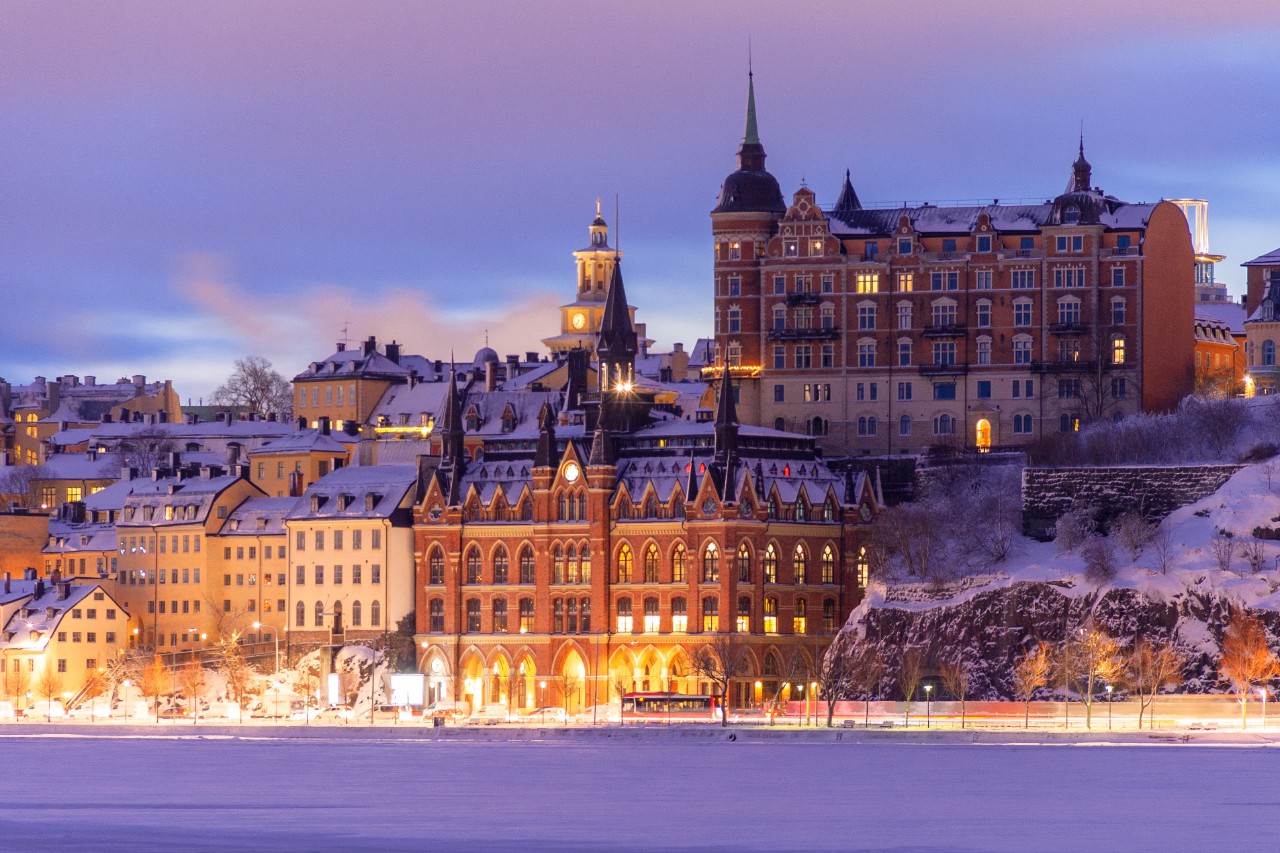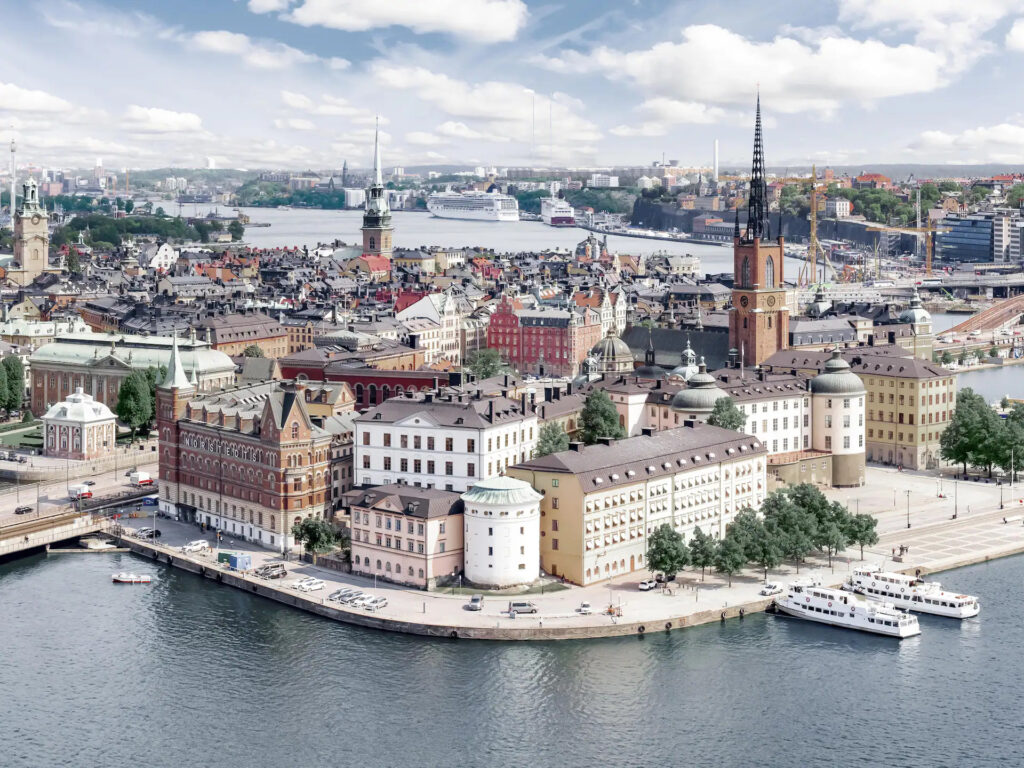Stockholm, a city where water and land intertwine seamlessly, offers a unique blend of the natural and the man-made, creating an architectural landscape that is as serene as it is sophisticated. The capital of Sweden is renowned for its harmonious combination of stunning natural vistas and minimalist Nordic design. From the historic cobblestone streets of Gamla Stan to the sleek, modernist lines of Södermalm, Stockholm architecture reveals a city that respects its past while embracing the future. This interplay between nature and design is celebrated in every corner, making Stockholm not just a place to live, but a destination to experience.
Gamla Stan: Preserving the Past
Gamla Stan, Stockholm’s old town, is a living museum of medieval architecture. Walking through its narrow, winding streets, one can feel the weight of history. The area is a treasure trove of well-preserved buildings dating back to the 13th century. The Stockholm architecture here is characterized by vibrant facades, cobbled alleys, and the imposing presence of the Royal Palace, a testament to the city’s regal history.
In Gamla Stan, the charm lies in the details. The intricate ironwork on doorways, the patina of age on the stone walls, and the warm glow of lanterns create an atmosphere that transports visitors back in time. This historic district is not just about preservation; it’s about living history. As you explore, you can see how the past influences the present, a theme explored in the evolution of architectural styles from ancient to modern times.
Djurgården: Nature’s Embrace
Djurgården, an island oasis in the heart of Stockholm, is a perfect example of how Stockholm architecture coexists with nature. This lush island is home to some of the city’s most cherished cultural institutions, including the Vasa Museum and the Nordic Museum. The architecture here is largely influenced by Sweden’s natural landscape, with buildings that complement the surrounding greenery.
Walking through Djurgården feels like stepping into a painting. The island is a sanctuary for both people and wildlife, offering a respite from the city’s hustle and bustle. The design of the buildings here respects the natural contours of the land, ensuring a seamless integration of architecture and nature. This approach mirrors the philosophy seen in other cities like Zurich’s architectural harmony.
Södermalm: Modern Minimalism
Södermalm, known for its bohemian vibe, showcases a different facet of Stockholm architecture. Here, modern minimalism takes center stage. The district is a hub for contemporary design, with sleek, innovative structures that push the boundaries of traditional architecture. The use of glass, steel, and open spaces reflects a commitment to sustainability and functionality.
Södermalm’s architecture is not just about aesthetics; it’s about creating spaces that enhance the quality of life. The focus is on clean lines, natural light, and open plans that encourage community interaction. This modern approach can be seen in other iconic structures around the world, such as those featured in the top architectural wonders of the 21st century.
The Royal Palace: A Regal Presence
The Royal Palace of Stockholm is a stunning example of Baroque architecture. This majestic building, with its 600 rooms, serves as the official residence of the Swedish monarch. Its grandeur and scale are matched by the intricate detailing that adorns its facade and interiors. The palace is not just a symbol of royal power; it is a masterpiece of design.
The architecture of the Royal Palace reflects the opulence and sophistication of its era. The careful craftsmanship and use of high-quality materials echo the grandeur seen in other significant structures like St. Peter’s Basilica in Rome. Visitors to the palace can experience firsthand the splendor of Swedish royal tradition.
Skogskyrkogården: A Sanctuary of Peace
Skogskyrkogården, or the Woodland Cemetery, is a UNESCO World Heritage site that exemplifies how Stockholm architecture can transform a space into a sanctuary of peace. Designed by renowned architects Gunnar Asplund and Sigurd Lewerentz, this cemetery is a place where nature and architecture flow in harmony. The landscape, with its rolling hills and towering pines, creates a serene environment for reflection.
The architecture of Skogskyrkogården is subtle yet profound. The use of natural materials and the integration of the landscape into the design emphasize a deep respect for nature. This serene space is a reminder of the power of thoughtful design in creating places of tranquility, similar to the Las Lajas Sanctuary, which captures spirituality through architecture.
The Stockholm Public Library: Enlightening Spaces
The Stockholm Public Library, designed by Gunnar Asplund, is a testament to the power of functionalist design. Its cylindrical shape and simple lines make it a standout example of Stockholm architecture. The building is designed to maximize natural light, creating an inviting atmosphere for readers and researchers.
Inside, the library offers a feast for the senses. The open, airy spaces are filled with books, inviting discovery and exploration. This focus on accessibility and enlightenment reflects a broader trend in Christian architecture where spaces are designed to uplift and inspire.
The City Hall: A Civic Masterpiece
Stockholm’s City Hall is a masterpiece of National Romantic style. Its brick facade and iconic tower are defining features of the city’s skyline. The architecture of City Hall combines elements of medieval and Renaissance design, creating a building that is both monumental and approachable.
Inside, the City Hall is a showcase of Swedish craftsmanship. The Golden Hall, adorned with mosaics, is a highlight, offering a glimpse into the artistry that defines Stockholm architecture. The building’s design emphasizes civic pride and is a testament to the city’s commitment to cultural heritage, much like the architecture of Paris, where historical and modern elements coexist.
The Ericsson Globe: A Modern Marvel
The Ericsson Globe, known for its distinctive spherical shape, is a marvel of modern engineering. As the largest hemispherical building in the world, it serves as an iconic example of innovative Stockholm architecture. The Globe is not just a sports arena; it is a symbol of Sweden’s forward-thinking design ethos.
The architecture of the Ericsson Globe is a celebration of form and function. Its unique design allows for versatile use, hosting everything from concerts to ice hockey games. This adaptability is a key feature of modern architectural wonders, as seen in places like the Sheikh Zayed Mosque, where design meets purpose.

Hammarby Sjöstad: Sustainable Living
Hammarby Sjöstad is a testament to Stockholm’s commitment to sustainable urban development. This eco-friendly district was designed with the goal of creating a self-sufficient community that minimizes its environmental impact. The architecture here focuses on energy efficiency and ecological balance.
The buildings in Hammarby Sjöstad are designed to harvest natural resources, using solar panels and green roofs to reduce energy consumption. The integration of nature into the urban environment is a hallmark of Stockholm architecture, ensuring a high quality of life for its residents. This approach addresses the problem with modern architecture by prioritizing sustainability over aesthetics.
The Vasa Museum: A Nautical Legacy
The Vasa Museum is a unique architectural and historical attraction in Stockholm. The museum houses the Vasa ship, a 17th-century warship salvaged from the depths of Stockholm Harbor. The building itself is designed to resemble ship masts, creating a visual connection to the maritime heritage it celebrates.
The architecture of the Vasa Museum is an example of how design can enhance storytelling. The structure’s form and materials evoke the feeling of being on a ship, immersing visitors in the narrative of the Vasa. This approach to design is reminiscent of the immersive experiences found in church building interiors, where architecture enhances the spiritual journey.
The Moderna Museet: A Canvas for Art
The Moderna Museet, located on Skeppsholmen island, is a beacon of contemporary art and design. The museum’s architecture, designed by Rafael Moneo, is characterized by its clean lines and open spaces, providing an ideal backdrop for the art it houses. The design reflects the minimalist aesthetic that defines much of Stockholm architecture.
Inside, the museum offers a dynamic space for exhibitions and events. The use of natural light and flexible layouts allows for a constantly evolving artistic experience. This commitment to adaptability is also seen in the Sagrada Familia in Barcelona, where architecture and art form a seamless partnership.
The Stockholm Waterfront: A Modern Skyline
The Stockholm Waterfront is a striking example of modern architecture. This development, consisting of office buildings and a conference center, is defined by its bold design and cutting-edge technology. The architecture of the Waterfront is a statement of Stockholm’s position as a global city.
The sleek, glass facades reflect the surrounding water and sky, creating a dynamic interplay of light and shadow. This modern approach to design emphasizes transparency and openness, qualities that are essential in contemporary urban landscapes. The Stockholm Waterfront is a testament to the city’s ability to innovate while respecting its natural surroundings, a balance also achieved in St. Petersburg’s architectural evolution.
Drottningholm Palace: A Royal Retreat
Drottningholm Palace, a UNESCO World Heritage site, is a stunning example of Baroque architecture. The palace and its gardens offer a glimpse into the opulence of Sweden’s royal past. The architecture of Drottningholm is characterized by its symmetry, grandeur, and intricate detailing.
The palace’s interiors are equally impressive, with lavish decorations and exquisite craftsmanship. The combination of architectural beauty and historical significance makes Drottningholm a must-visit for anyone interested in Stockholm architecture. The palace’s design and setting evoke the splendor of other royal residences, such as those highlighted in Heaven on Earth: Divine Buildings.
The Nobel Prize Museum: Celebrating Innovation
The Nobel Prize Museum, located in the heart of Stockholm, is a celebration of human achievement and innovation. The museum’s architecture is designed to inspire, with spaces that encourage exploration and reflection. The design incorporates elements of Swedish modernism, creating a welcoming and engaging atmosphere.
The architecture of the Nobel Prize Museum reflects the spirit of the awards it celebrates. The use of modern materials and technology creates an environment that is both informative and inspiring. This focus on innovation and excellence is a theme shared by many modern architectural projects, such as those featured in Zurich’s architectural innovations.
The ABBA Museum: A Tribute to Pop Culture
The ABBA Museum, dedicated to Sweden’s most famous pop group, is a fun and interactive experience. The museum’s architecture reflects the energy and creativity of the music it celebrates. The design is characterized by vibrant colors and playful elements, creating an engaging environment for visitors.
Inside, the museum offers a journey through the history of ABBA, with interactive exhibits and memorabilia. The architecture enhances the visitor experience, making it a must-see for fans of Stockholm architecture and pop culture alike. This playful approach to design is reminiscent of other cultural landmarks, such as the Las Lajas Sanctuary, where architecture becomes part of the narrative.
Conclusion
Stockholm’s architectural landscape is a testament to the city’s ability to harmonize nature and design. From historic districts to modern marvels, Stockholm architecture offers a rich tapestry of styles and influences. This blend

Recent Posts
15 Floor Plan Graphic Styles That Will Elevate Your Presentation Game
The Role of Shadows in Architectural Storytelling
When Furniture Becomes Architecture: Blurring the Line